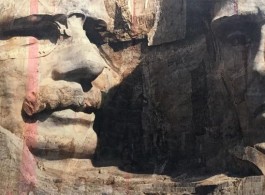Curated by Bao Dong
09.12.2016 – 26.02.2017
Opening|开幕时间:2016年12月9日 16:00 – 18:30pm
Duration|展览日期:2016年12月9日- 2017年2月26日
Location : de Sarthe Gallery – Beijing, 328-D, Caochangdi, Chaoyang District, 100015 Beijing, China
地址:北京德萨画廊,北京市朝阳区草场地艺术区328-D
de Sarthe Gallery is pleased to present a solo exhibition by Liang Ban, entitled Landscape Browser, opening on December 9th in Beijing. Featuring new work that encompasses installation, video, and spray paint, Liang Ban’s first solo exhibition at de Sarthe Gallery will continue through February 26th, 2017.
Liang Ban’s practice gained recognition with his groundbreaking “Hand of God” (2015) series. In this series the artist traversed deserts, forests, rivers and various other landscapes while carrying his mobile phone in order to connect the device’s internal operating system with the external environment around him. He achieved this by displaying images of scenery onto the mobile phone, then staging phone within the landscape and recording the resultant dialogue between device and nature. The videos portray a seemingly innocuous moment, but while viewing the work one quickly realizes the poetry contained within addresses contemporary notions of society, culture, and most prominently-landscape. An important component of Landscape Browser, the “Hand of God” series begins a conversation about the connotations and implications of landscape and how the subject is portrayed as a social commodity today.
Furthering an exploration of landscape, a major installation, “Evening Ramble” (2016) recreates a version of the Mount Rushmore National Memorial in the gallery. Unlike the actual memorial, “Evening Ramble” is covered in dirt, grime, and bird droppings made by a living parrot. Another piece titled “The Earth Magician No.1″ (2016) is a 3D topological map that is hung on a wall of the gallery and covered with phosphorescent spray-paint that extends off of the map and onto the wall itself. A new video work, “Hole” (2016), plays in reverse footage of Coca-Cola cans and coins being thrown into a deep cave. Collectively, the artworks approach an alternate and critically engaging theory behind the significance of landscape in contemporary global society.
Born in 1985 in Guangxi province, China, Liang Ban currently works and lives in Beijing. He attended the Guangxi Art Institute in Nanning, China, from which he graduated in 2010 with a B.F.A. Liang Ban’s solo exhibitions include Slightly Confused, Taikang Space, Beijing, China (2016) and Game, A-4 Contemporary Arts Centre, Chengdu, China (2014). Recent group museum exhibitions include Position Fixing, Arte Place at the Guangzhou Opera House, Guangzhou, China (2016); Turning Point: Contemporary Art in China Since 2000, Minsheng Art Museum, Shanghai, China (2016); Olhares Interiores, Macao Museum of Art, Macao (2015); Polyphony II – Ecological Survey of Chinese Art – Beijing, Art Museum of Nanjing University of the Arts, Nanjing, China (2014); Individual Growth – The Momentum of Contemporary Art, Shijiazhuang Art Museum, Shijiazhuang, China (2013) and Living . Being, Songzhuang Art Museum, Beijing, China (2012).

Liang Ban, Evening Rambles, 2016, Aluminum structure, UV Flatbed Print on wood board and specimen Parrot (detail shot), 394 x 685 x 11 cm, dimensions variable
Curatorial Statement
Looking back upon the history of western culture, we find that starting with romanticism landscape became recognized as an independent subject matter in its own right. As landscape was reckoned as “pure nature,” landscape painters were hailed as the “eye of purity and innocence.” Due to its dominant role in the visual narration of history in the 19th century, landscape painting became one of the driving forces behind the revolution of modern art. However, it is worth pointing out that other than the delineation of the nature, landscape is often laden with social significances. The depiction and even photographing of landscape and the transmission of these images have come to be intricately related to politics. Landscape is an integral part of the internal construction of modern nations and the aesthetic ideology of urban bourgeoisie, as well as the projection of western centralism. In this regard, so-called “pure and natural” landscape does not actually exist. In essence, “Landscape” is merely an object produced via seeing.
Within the exhibition, a billboard featuring Mount Rushmore, a topographic map covered with graffiti, a blackballed painting dappled with stars, a cave from which Coca-Cola cans are tossed out, and the various landscape pictures used as screensavers on mobile phones all offer an experience of landscape that is anything but pure, and even absent of the standard experience associated with the subject. In this exhibition, Liang Ban manages to separate “seeing” from “landscape.” On the one hand, he endeavors to present “landscape” as cultural object (political logo, technical sign, cultural product and media content) rather than a natural object; and on the other hand, by detaching the images of landscape from the social systems they usually belong to, he changes “landscape” into a symbol and allows it once again to become an object produced via seeing. In an era when the most immediate response people have when they encounter the beauty of nature is to take out their smartphones, we no longer even “see,” we simply “browse.”



